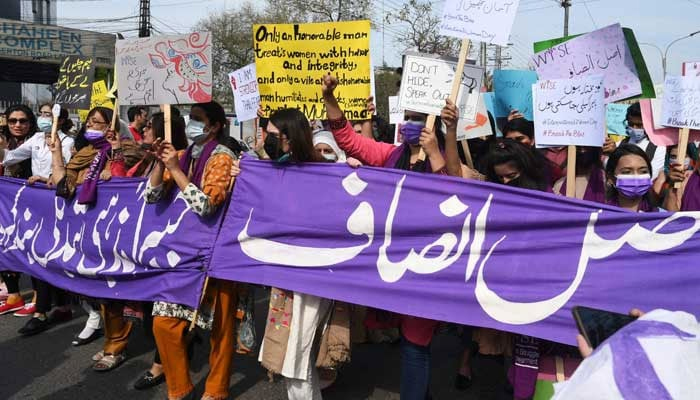Invisible women
The recently released UNDP 2023 Gender Social Norms Index (GSNI) reveals the shocking persistence of gender biases globally. The index tracks people’s attitudes towards women across four dimensions – political, education, economic and physical integrity in both lower and higher HDI countries.
Covering 85 per cent of the world’s population, the GSNI reveals that a staggering nine out of 10 men and women still hold gender biases against women, indicating that 90 per cent of the world’s population holds at least one bias against women. Twenty-five percent of the population believe it is justified for a man to physically harm his wife.
Nearly half of the respondents believe men are better suited for political leadership, and 43 per cent hold the belief that men make better business executives compared to women. Furthermore, 28 per cent people think that higher education is more important for men than for women.
Despite the global and national-level commitments to gender equality, there is not a single country in today’s world that can truly claim itself as a gender-just society. The GSNI claims that women spend twice as much time on average on domestic and care work as compared to men. Women’s time spent on unpaid care work accounts for most of the recent variation in the gender gap in income. Women account for 28 per cent of managers and 31 per cent of top leaders in public administration globally. Women hold just over a quarter of parliament seats and 22 per cent of ministerial positions. Heads of states or women in government have remained around 10 per cent since 1995.
The global presence of gender biases demands a more profound analysis of the underlying causes that perpetuate these biases and reinforce gender stereotypes, hindering the equal access to opportunities and resources for women to fully develop their human capital.
The woman question is intertwined with the broader global systems of social and economic production processes that are historically based on exploitation and oppression along the lines of class, gender and race and other social divisions. Patriarchy as a pre-historic phenomenon has been changing with the mode of production and relations of production from primitive to slave, feudal, capitalist and socialist formations in human society.
It is indeed not surprising that in the patriarchal neo-liberal capitalist world of the 21st century, progress towards achieving gender equality promised in the Sustainable Development Goals (SDGs) and the Convention on the Elimination on all forms of Discrimination against Women (CEDAW) is frustratingly slow. As gender inequality is one of the organizing principles of capitalist production, it is impossible to achieve gender equality in class-based societies.
Political rights and civil liberties have been in decline worldwide. Global space for freedom is shrinking, and polarization, militarization, fundamentalism, extremism is on the rise. Increasing poverty and high unemployment accompanied by conservative backlash is putting democratic practices under stress in general and women’s rights for equal participation in economic, politics and civic spaces in particular.
Gendered social norms are deeply rooted in the ideology of sexual division of labour (SDL), which assigns distinct roles to men and women in society. Men are expected to be the primary breadwinners, occupying positions in the public sphere, while women are assigned the primary role within the private arena of homes as mother, wives and caretakers. The public-private divide forms the basis for investing less resources to build women’s human capital as they are not expected to be economically independent.
The gender role ideology serves as a smokescreen to not only invisibalize women’s role in the public sphere but also undermine the economic value of women’s reproductive labour within the domestic sphere. Reproductive labour is essential for the productive sphere.
The unpaid domestic labour of women keeps the living wages of productive labour low for the capitalist class and contributes to increased profit margin and capital accumulation. Within this socio-economic formation, gender equality is no more than a rhetoric at the domestic and global levels.
The trajectory to gender equality proposed in the GSNI is education, recognition and representation. The index proposes two key blocs of action. The first block aims to shape gender-sensitive policy interventions and institutional reforms and the second block focuses on the significant role of the social context in shaping attitudes and behaviors.
While there is nothing wrong with this proposed way, it cannot be achieved through reformist interventions within systems of exploitation and oppression. Gender social norms are embedded in institutional arrangements and social practices.
Gender inequality is a systemic issue, which necessitates challenging and transformative measures aimed at dismantling the capitalist patriarchal systems of production and reproduction and the social context. This calls for a systematic approach to challenge socio-cultural, economic and political frameworks that perpetuate gender inequalities.
Therefore, instead of lamenting the persistence of gender inequalities, it is important to identify the structural basis of the hierarchical gender social order – gender norms that are deeply ingrained in our collective psyche.
Biases against women are sustained by social arrangements and practices, and addressing them depends greatly on social change at large. However, people are not the passive victims of hegemonic ideologies. They can challenge regressive social norms and practices through activism and social movements.
Although men and boys stand to gain from gender norms that perpetuate men’s exercise of power over women, they do suffer from the hegemonic notion of hyper masculinity too. Gender consciousness amongst men and women can play a critical role in challenging patriarchy and overcoming the obstacles to women’s empowerment and to the alternative forms of masculinity.
The trajectory to achieve gender equality must be linked with the liberation movements nationally and globally to free human society from the clutches of capitalist patriarchy.
The writer is a human rights activist and ex-director Gender Studies, QAU. She can be reached at: drfarzanabari@gmail.com
-
 Meghan Markle's As Ever Facing Branding Problems?
Meghan Markle's As Ever Facing Branding Problems? -
 Kate Middleton Is More Relaxed In 'Wellington Boots Than Diamond Tiara'
Kate Middleton Is More Relaxed In 'Wellington Boots Than Diamond Tiara' -
 Gaten Matarazzo Addresses Important Fans Query About 'Stranger Things'
Gaten Matarazzo Addresses Important Fans Query About 'Stranger Things' -
 Prince William's Latest Move Reveals Rift Is Strong With Prince Harry
Prince William's Latest Move Reveals Rift Is Strong With Prince Harry -
 Princess Eugenie Becomes Second Royal After Meghan To Feature In Viral Trend
Princess Eugenie Becomes Second Royal After Meghan To Feature In Viral Trend -
 Carol Burnett Sings Praises Of Late Jimmy Stewart: 'He Had THIS'
Carol Burnett Sings Praises Of Late Jimmy Stewart: 'He Had THIS' -
 Kate Middleton Dashes Through Rain At Windsor Castle
Kate Middleton Dashes Through Rain At Windsor Castle -
 Dave Filoni, Who Oversaw Pedro Pascal's 'The Mandalorian' Named President Of 'Star Wars' Studio Lucasfilm
Dave Filoni, Who Oversaw Pedro Pascal's 'The Mandalorian' Named President Of 'Star Wars' Studio Lucasfilm -
 Is Sean Penn Dating A Guy?
Is Sean Penn Dating A Guy? -
 Sebastian Stan's Godmother Gives Him New Title
Sebastian Stan's Godmother Gives Him New Title -
 Alison Arngrim Reflects On 'Little House On The Prairie' Audition For THIS Reason
Alison Arngrim Reflects On 'Little House On The Prairie' Audition For THIS Reason -
 Spencer Pratt Reflects On Rare Bond With Meryl Streep's Daughter
Spencer Pratt Reflects On Rare Bond With Meryl Streep's Daughter -
 'Stranger Things' Star Gaten Matarazzo Recalls Uncomfortable Situation
'Stranger Things' Star Gaten Matarazzo Recalls Uncomfortable Situation -
 Gaten Matarazzo On Unbreakable Bonds Of 'Stranger Things'
Gaten Matarazzo On Unbreakable Bonds Of 'Stranger Things' -
 Beyonce, Jay-Z's Daughter Blue Ivy Carter's Massive Fortune Taking Shape At 14?
Beyonce, Jay-Z's Daughter Blue Ivy Carter's Massive Fortune Taking Shape At 14? -
 Meghan Markle Fulfills Fan Wish As She Joins Viral 2106 Trend
Meghan Markle Fulfills Fan Wish As She Joins Viral 2106 Trend




